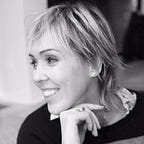An animator’s mind tackling comics: Using what I know to tackle knew frontiers
This post was originally published on my pateron page Hugo and Irina.
I am starting a comic from scratch. The stories are drawn from real events, scrambled through my brain, caricatured onto tracing paper, and re-assembled digitally. Along the way I’ll sharing my experience from the point of view of motion artist tackling a new creative medium.
Being a motion graphics artist by profession, I am approaching this project like I would an animation.
What’s a motion graphics artist?
A motion graphics artists (aka mographer), is a professional who works with the moving image. A mographer can be either a designer, an animator or both, (as is my case).
A mographer applies motion to graphic design elements. eg: Typography can be used in a film’s title sequence, or a logo can build up at the end of a commercial. There are countless examples of motion graphics in all of our digital media.
My process for my comic thus far:
1. Write a script
2. Roughly sketch the frames out.
What is a Frame?
It is in the artist’s power to crop into a world and lend his/her vision to the viewer.
In animation, film or any other form of moving art, elements are framed to form a visually pleasant composition. Apart from aesthetics, framing can also position elements tactically within a composition to form a story.
If there is motion happening, you may need more than one frame to clarify a storyline. Frames placed in a sequential order will reveal a sequence of events.
If we were to simplify this: The frame is your “what?” And the sequence is your “how?”
Like in animation, comics also use framing to tell a story. Sometimes one vignette is enough, at others you need several steps to tell a story.
3. Once I have a good idea of what is happening in all my frames, I begin to isolate elements and draw each piece individually.
Why do I draw my elements out separately?
For starters, it’s because I am new to illustration and need to focus on each item separately. I start with a pencil and tracing paper, then draw and re-draw until I reach something I like. I trace my final drawing with a marker (this takes me quite a few tries!).
Second, animation has accustomed me to a workflow that prioritizes efficiency. If many of my scenes are going to happen in the same setting, I don’t want to keep redrawing the scenes from scratch every time. By building a library of elements, I will be able to re-use bits and pieces, helping me speed up the technical aspect of things. This allows me more time for storytelling.
Once I have all my pieces, I scan and vectorize all the elements. (Vectorizing the images gives me the flexibility to resize and reshape elements without losing definition.)
4. After having made any adjustments digitally, I am ready to composite my scene.
So here we are on week 2 of my making a comic from scratch challenge! I wouldn’t be surprised if in time my process changes. Processes change through out any project, let alone a new medium. I am excited to keep learning and sharing my experience with you.
If you have experience you’d like to share or any questions, I’m all ears.
